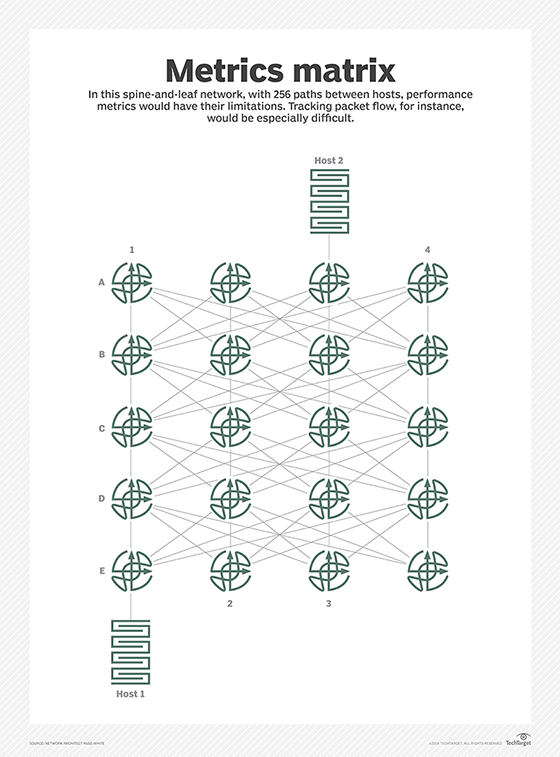network performance monitoring
Network performance monitoring is a process of measuring and monitoring the quality of service of a network to understand if it is properly operating.
Network performance monitoring aids network administrators and analysts in gathering network data, allowing them to measure performance variables and identify potential issues or risks. Network performance monitoring tools will help in handling the management between linked devices, as well as gathering metrics from servers or other linked devices. After this, a network performance monitoring tool will analyze the collected data to find any bottlenecks or congestion points, so the network can increase its throughput once fixed. Some of these tools can be automated to make the process easier. These tools can create reports and alert users when any issues appear. Ideally, this will allow network admins to address issues before they become bigger problems.
Enterprises with strict reliability requirements have driven the need for network performance monitors. As network architecture grows in complexity, and application delivery becomes more time-sensitive, the need for a network performance monitor rises. Today's network monitoring tools must have a mix of scalability, capability and usability.
Network monitoring should be top of mind for IT teams.
Why is network performance monitoring important?
Network performance monitoring is an important general IT process that allows administrators to optimize a network's performance -- especially in organizations with strict reliability requirements and in network architectures that are complex. Networking components such as servers, routers, switches and virtual machines (VMs) can be monitored for performance.
If there are bottlenecks in a network, then user experience will be negatively affected. This is why network performance monitoring must consider what the user experience will be like by monitoring the network for bottlenecks or congestion and providing better throughput.
How does network performance monitoring work?
Network performance monitoring collects data from multiple sources. It works by monitoring flow data, Simple Network Management Protocol (SNMP) and packet capture.
- Flow data is generated by network device This data should provide information such as what devices are communicating, how long they communicate and how often. This should also give information on how much data is being transferred.
- SNMP is a widely used protocol that monitors and manages the function of network devices. Many network and endpoint devices support SNMP -- such as routers or printers. SNMP can be used to continually monitor network changes or status in real time.
- Packet capture is what aids in monitoring network health, as well as application network performance, monitoring security and incident responses, troubleshooting service issues and network capacity planning. This will capture a packet that crosses a specific point within a network. Once copied, a packet will be stored so it can be analyzed.
A network performance monitoring tool will typically also provide visualization and reporting in a customizable dashboard. Packet capture, SNMP support and flow data all should be collectible and viewable within a network performance monitoring tool. If any issues are detected, users of the tool should be able to quickly isolate and analyze the issue.
Network performance monitoring can be used on premises, from the cloud or in a hybrid manner.

What are network performance monitoring metrics?
Metrics that network performance monitoring tools should keep track of include errors, bandwidth, throughput and latency.
- Errors refer to the percentage of errors received due to network issues, such as with packet loss Packet losses, as an example, have to do with the number of packets that were sent successfully but didn't reach their destination.
- Bandwidth is a measurement of the maximum amount of data that can be transferred through a network over a specified time period. Typically, this time period is measured in bits per second. Bandwidth is a measure of capacity, as opposed to a measure of speed.
- Throughput is the measure of how many units of information a system can process in a given amount of time. This is more of a measure of speed because it relates to aspects such as response time.
- Latency is a measure of how much time it takes for a data packet to travel from one designated point to another. Latency is also a synonym for delay. This measurement ideally should be as close to zero as possible.
Network performance monitoring benefits and challenges
Network performance monitoring benefits are as follows:
- Any unusual behavior in a system can be detected and removed before it becomes a bigger problem, thus minimizing risk.
- Fewer errors and latency in network traffic -- both of which can be detected by a network performance monitoring tool -- will lead to a better end-user
- Optimized performance can be beneficial by identifying problem areas and collecting performance data.
- Some tools can also identify malicious activity. Unusual behavior and network security threats can be kept track of and flagged.
- Private cloud models offer more flexibility and control due to being within a private cloud.
- Public clouds will be more cost-effective.
- Virtualized and automated networks can benefit enterprises by increasing efficiency and scalability.
Challenges in network performance monitoring are as follows:
- Added complexity can be a challenge in some cases, as some tools can't access virtualized layers.
- For automated networks, IT teams need to oversee automated activities to ensure the network is properly monitored. Tracking automated changes isn't always simple.
- In some cases, VMs can't properly communicate to relay necessary information, meaning IT teams should monitor the individual VMs and the hypervisor
- Virtualized and automated networks could also mask performance issues.
Network performance monitoring tools
Some network performance monitoring vendors will choose to target smaller businesses with traditional network performance monitoring tools. However, most vendors address the problems larger businesses face due to an increased demand for reliable network services. Some example vendor tools include:
- Cisco DNA Analytics and Assurance is part of a larger collection of major building blocks used in Cisco's advanced intent-based networking architecture called Digital Network Architecture (DNA). Cisco DNA Analytics and Assurance is a network service and device monitoring product. Although an end-to-end Cisco architecture is needed to get the most out of the tool, it can still collect telemetry information from non-Cisco endpoints, devices and applications.
- Juniper Mist WLAN and Contrail SD-WAN is a cloud service that enables customers to monitor Mist access points regardless of the location of deployment. Juniper's acquisition of Mist brought WLAN performance analytics to the tool. The tool also uses AI to correlate wireless anomalies with automated root cause analysis and steps to remediate issues.
- Broadcom DX NetOps is Broadcom's performance monitoring tool, which has several standalone CA monitoring, analytics and alerting tools bundled together. Broadcom DX NetOps can capture critical performance metrics in network infrastructures using SNMP, NetFlow, REST, streaming telemetry and other network and application measures. The tool can analyze collected information and display the health of LAN, WLAN, SD-WAN, software-defined data centers and cloud services. The product is well suited for multivendor networks equipped with legacy and modern network components.








